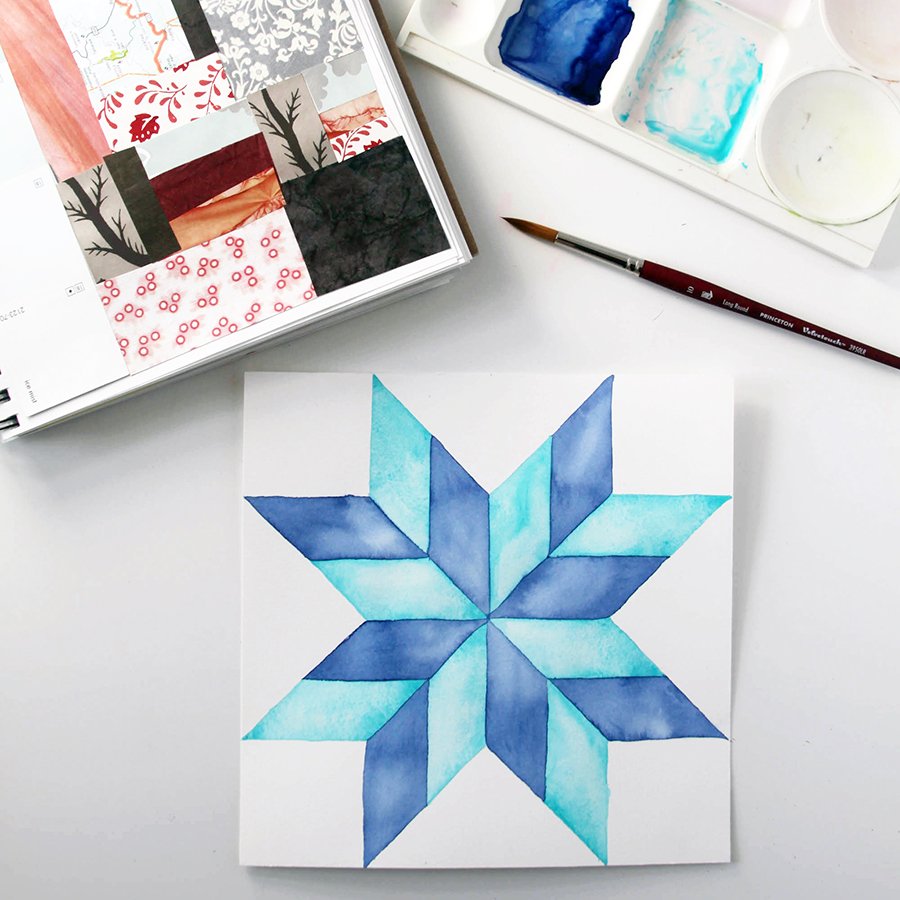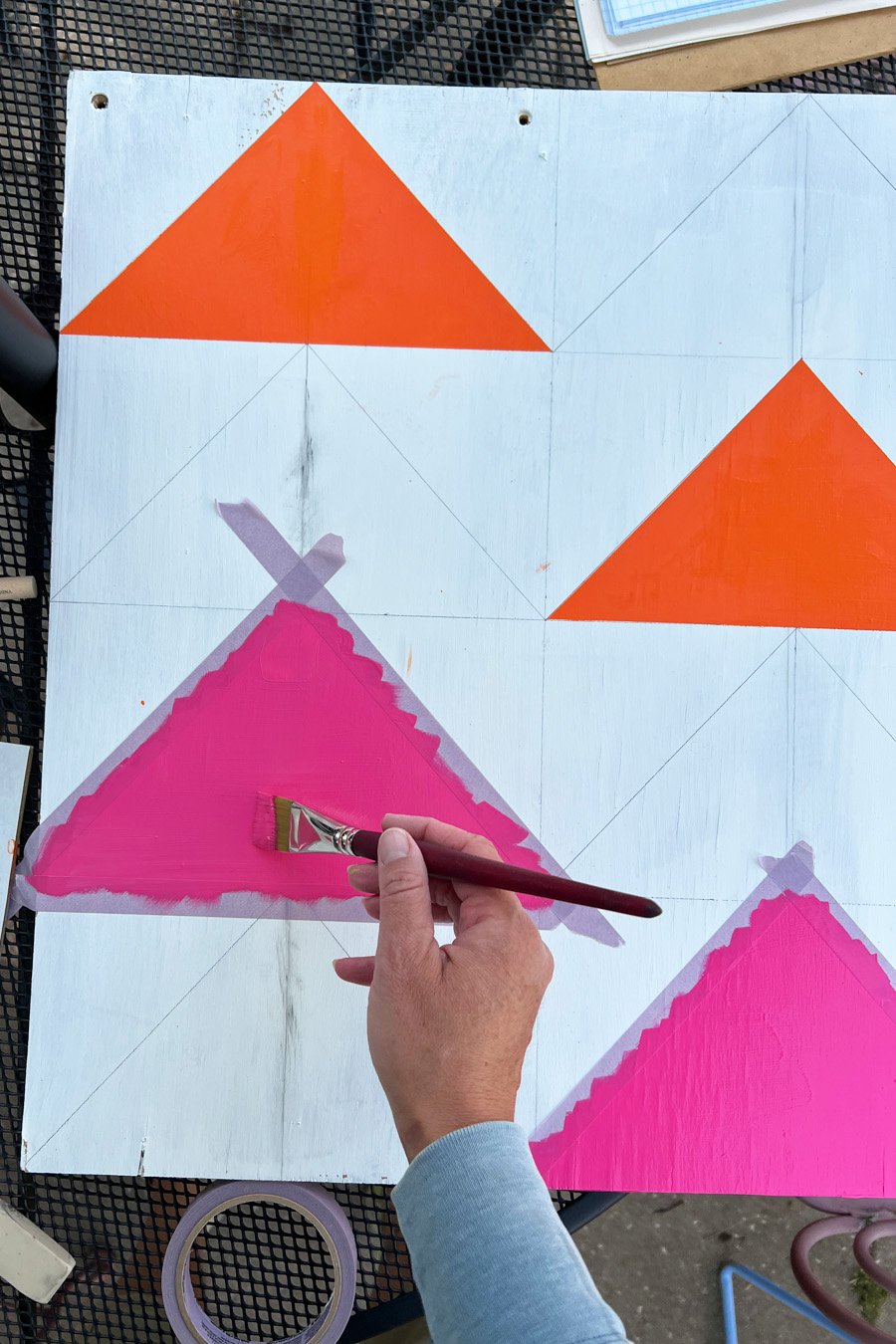Painting in the Garden, A Fun and Different Project: Barn Quilts
Some projects live in my head for a very long time before I get around to bringing them into the world. Painting a series of “barn” quilts for my house and garden is one of those projects.
I can’t remember when I first had the idea to create a painted quilt to hang outside, but I know it was quite a few years ago. I’ve always enjoyed seeing barn quilts — large painted quilt blocks — hanging on barns. Fascinated by the phenomenon, I read a couple of books about them.
I’ve sewn my own fabric quilts, painted quilt-inspired designs using watercolor (it’s even a project in my class Overcome Creative Slumps With Easy Art Play) and collaged paper quilts in my sketchbooks.
It was a natural progression to want to paint larger quilts to hang outside.
When I first started thinking about the project I knew I wanted to use scrap wood, but I didn’t have anything on hand that would work. I kept my eye out, hoping to salvage something I could use. One day on a walk I found some pieces of wood discarded on the curb. They were a bit rough but I thought they could work.
I primed them. But then they sat.
And sat.
And sat.
Part of the problem was that I wasn’t sure which quilt block designs I wanted to use. I wasn’t sure what type of paint to use, either.
I checked out the books about barn quilts from the library (again) and looked at fabric quilt designs for inspiration. I played with ideas in my sketchbook.
But still the primed pieces of wood sat in my studio.
When I moved my studio this summer, the primed boards reignited a spark of inspiration. I checked out the barn quilt books from the library (yet again), but this time I got to work.
The first barn quilt in one of the books uses a flying geese design. The block is simple, just a series of triangles. It’s is rectangular and so is my wood.
Perfect!
After a bit of measuring and a bit of math, I drew out my design.
Although I’m not sure about its long-term durability, I decided to use acrylic paint so I could mix any colors I wanted (and not have to buy new paint). Using found wood and inexpensive paint made me less worried about “messing up”.
Once I decided on the design and the paint, I had to choose colors.
Many of the flowers in my garden are pink or orange, so it felt like a good starting point for my color palette.
Walking past my caladium plant sparked another idea.
The dark pink and the lighter pink are so pretty together. Why not use two versions of both pink and orange? The snapdragon mix I’m growing was yet another nod toward this combination.
Once I started thinking about it, I saw these colors, and combinations of light and dark versions of them, repeated again and again throughout my garden.
Inspiration is everywhere!
Next it was time to paint.
For the cleanest lines, I used tape to mask off my triangles.
It’s so satisfying to peel off the tape and reveal the perfect shapes beneath.
Each triangle required a couple of coats. And I needed to make sure the paint was entirely dry before moving on to the overlapping shapes.
I loved the pink and orange against the white, but because my house and garage are both white, I knew I wanted another color so the quilt would stand out against the wall.
I turned to my garden for inspiration again and mixed a limy green.
The finished quilt makes me so happy!
As does the fact that I finally tackled a project I’d been dreaming about for years.
After the paint was fully dry, I used a spray-on sealer with a matte finish designed for outdoor use.
When I enlisted Matthias’ help to hang my finished quilt, he pointed out that the wood I used (worn plywood), even with the primer, paint and sealer, will not last well in the elements. Instead of hanging it on the back of the garage as I had planned, we put it on the side, where it will be a bit more protected by the overhanging eaves.
I like the quilt here better than where I’d planned to hang it. It’s much more visible. I see it every time I enter the garden and I can even see it from the kitchen sink!
Which brings me so much joy!
I’m working on a second flying geese design with my other piece of found wood.
I haven’t decided which other colors I want to use or where I want to hang the finished piece, but I learned from the first quilt that sometimes I just need to make a decision and dive in. I hope to create a series of more designs and hang them throughout my garden.
The books I’ve read don’t teach how to make barn quilts but I did a bit of research online and found that there are differing opinions as to what types of materials are best to use. Some recommend plywood. Others, including this one, suggest aluminum composite sheets. For now I’m going to continue using what I have on hand, but eventually I’d like to make some using longer-lasting materials.
If you’d like to make your own “barn” quilts, don’t put too much pressure on yourself. Start simple, use what you have and have fun!
To learn more about the barn quilt phenomenon, get your hands on a copy of Suzi Parron’s books Barn Quilts and the American Trail Movement and Following the Barn Quilt Trail or visit her barn quilt website where you can find the barn quilt trails in your area.
Books about quilts and quilting are another great source of inspiration. A few I have checked out right now:
Modern Quilts Traditional Inspiration: 20 New Designs with Historic Roots by Denyse Schmidt (also, not pictured her book Quilts: 30 Colorful Quilt and Patchwork Projects)
Quilt Local: Finding Inspiration in the Everyday (with 40 projects) by Heather Jones
The Improv Handbook for Modern Quilters: a Guide to Creating, Quilting & Living Courageously by Sherri Lynn Wood
Quilt Improv: Incredible Quilts from Everyday Inspirations by Lucie Summers
I especially love that designs in Heather Jones’ and Lucie Summers’ books are inspired by the world around us including such mundane things as buildings, tire treads and thrift shop plates. Inspiration truly is everywhere!
What about you?
Do you have a project that’s been simmering away on the back burner (maybe for years)? Wouldn’t now be the perfect time to tackle it?














